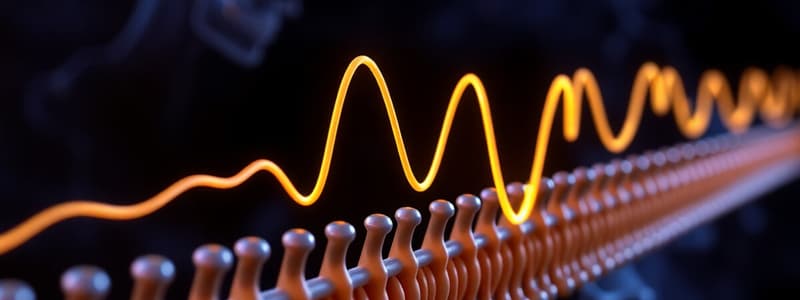Podcast
Questions and Answers
What is the main function of the refractory period in nerve fibers?
What is the main function of the refractory period in nerve fibers?
- It ensures impulses flow in both directions.
- It limits the rate of impulses to 500-1000 per second. (correct)
- It increases the rate of impulses along a fiber.
- It enhances the resting potential of the fiber.
What happens during the absolute refractory period?
What happens during the absolute refractory period?
- The nerve fiber can be restimulated by a weaker stimulus.
- It is impossible to restimulate the fiber. (correct)
- The sodium ion channels are completely open.
- The axon can conduct impulses in either direction.
What is primarily responsible for restoring the resting potential after an action potential?
What is primarily responsible for restoring the resting potential after an action potential?
- Sodium/potassium pump and membrane permeability to potassium ions. (correct)
- Chloride ions and their influx.
- Calcium ions and their channels.
- Magnesium ions and their diffusion.
What initiates the wave of depolarization in a neurone?
What initiates the wave of depolarization in a neurone?
In what time frame does the absolute refractory period occur?
In what time frame does the absolute refractory period occur?
What characterizes the relative refractory period?
What characterizes the relative refractory period?
What does the recovery time of an axon refer to?
What does the recovery time of an axon refer to?
How does the refractory period affect impulse direction along nerves?
How does the refractory period affect impulse direction along nerves?
What triggers the opening of sodium ion channels in the next region of the neurone?
What triggers the opening of sodium ion channels in the next region of the neurone?
What happens to the permeability of the axon membrane during depolarization?
What happens to the permeability of the axon membrane during depolarization?
What is the potential difference across the membrane at the peak of the action potential?
What is the potential difference across the membrane at the peak of the action potential?
What occurs immediately after depolarization in the action potential process?
What occurs immediately after depolarization in the action potential process?
What defines the threshold for triggering an action potential?
What defines the threshold for triggering an action potential?
What is the duration of the depolarization phase in the action potential?
What is the duration of the depolarization phase in the action potential?
What is the typical shape of the oscilloscope trace during an action potential referred to as?
What is the typical shape of the oscilloscope trace during an action potential referred to as?
Why do potassium ions diffuse out of the axon during repolarization?
Why do potassium ions diffuse out of the axon during repolarization?
What mechanism restores the resting potential after an action potential?
What mechanism restores the resting potential after an action potential?
Which of the following statements about the action potential is incorrect?
Which of the following statements about the action potential is incorrect?
During which phase does the inside of the axon become negative relative to the outside again?
During which phase does the inside of the axon become negative relative to the outside again?
Flashcards are hidden until you start studying
Study Notes
Action Potential Overview
- Impulse along an axon changes cell membrane permeability to sodium ions due to stimuli or neurotransmitters.
- Experimental stimulation often involves controlled electrical impulses.
Depolarization Phase
- Stimulation increases axon membrane's permeability to sodium ions.
- Sodium ion channels open, allowing rapid diffusion of sodium ions, reversing membrane potential briefly.
- Depolarization lasts approximately 1 millisecond, peaking at about +40mV, known as the action potential.
- This process occurs in all nerve fibers, not just axons.
Repolarization Phase
- Sodium channels close post-depolarization; excess sodium is pumped out.
- Voltage-dependent potassium channels open, allowing potassium ions to diffuse out.
- Inside of the axon becomes negatively charged again, restoring the resting potential over a few milliseconds.
Action Potential Recording
- Action potentials can be recorded with an internal/external electrode setup using an oscilloscope.
- Oscilloscope trace appears as a 'spike', illustrating potential differences during sodium influx and resting potential recovery.
Threshold and All-or-Nothing Response
- Threshold is reached when sufficient sodium channels open, allowing sodium influx to surpass potassium outflow.
- The action potential is an all-or-nothing response; its magnitude remains consistent regardless of stimulus strength.
Refractory Period
- Crucial for nervous system function, limiting impulse flow to 500-1000 per second and ensuring unidirectional impulse propagation.
- The refractory period includes two phases:
- Absolute refractory period: Initial phase post-action potential where restimulation is impossible due to blocked sodium channels.
- Relative refractory period: Occurs after absolute, where stronger stimuli are needed for re-stimulation.
Propagation of Action Potential
- Action potential spreads along the neuron as a wave of depolarization:
- Sodium ions entering cause adjacent sodium channels to open.
- This initiates sodium influx in nearby regions, creating a continuous wave.
- The wave moves away from refractory membrane areas that cannot initiate new action potentials.
Studying That Suits You
Use AI to generate personalized quizzes and flashcards to suit your learning preferences.




